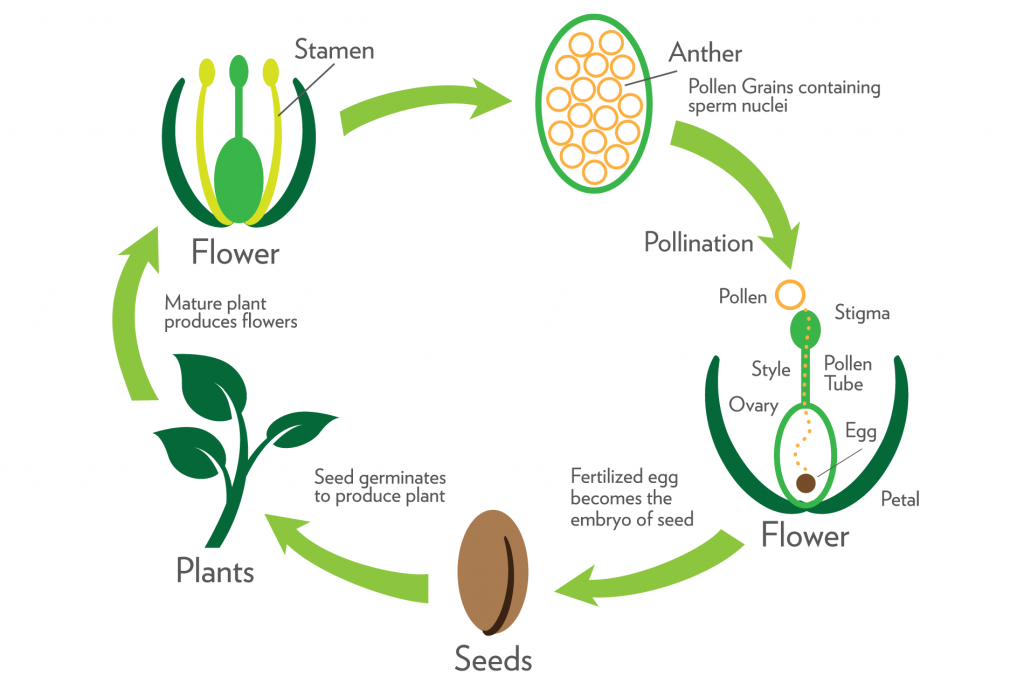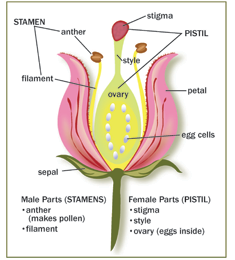Sexual Reproduction
It is a type of reproduction in which both sexes, i.e. male and female are involved. Sex cell of one parent (male) fuses with the sex cell of another parent (female). This results in production of a new cell called zygote.
The Zygote grows and develops into an organism with highly specialized tissues and organs. Simple organisms have almost similar size of germ cells that are not very different from each
other, whereas in complex organisms, the size of germ cells varies greatly. In these organisms, the germ cell with larger food stored is known as female gamete.
The other germ cell which is smaller and motile, is known as male gamete.
The sexual mode of reproduction involves two major processes :
- Formation of gametes by meiosis
- Fusion of gametes
Also Check – How do Organisms Reproduce Class 10 -Notes
Flowers
Flowers are the reproductive organs of flowering plants. Many flowers are brightly coloured to attract small animals called pollinators. These animals carry sex cells from the male parts of a flower to the female parts of another flower.
Sexual Reproduction in Flowering Plants

Flowers are the reproductive organs of flowering plants. Many flowers are brightly coloured to attract small animals called pollinators. These animals carry sex cells from the male parts of a flower to the female parts of another flower.
Flowering plants are generally angiosperms. They bear the reproductive parts within the flower and their seeds are enclosed in a fruit.
Flowers are of two types
Also Check – Asexual Reproduction
Bisexual Flowers
Most plants have both male and female reproductive organs in the same flower and are known as bisexual flowers, e.g. lily, rose, Hibiscus, mustard, etc.
Structure of Bisexual Flower
Stalk
- The stalk or pedicel supports the flower. Some flowers may be without stalks .
- The tip of the stalk may also be enlarged to form a cup-shaped receptacle or thalamus.
The floral parts are borne on the thalamus in four whorls.
- First whorl – green sepals (collectively called calyx).
- Second whorl large brightly-coloured petals (collectively called corolla).
- Third whorl (male parts) long thread-like structures somewhat projecting out and each usually ending in a bilobed tip. These are stamens (collectively named androecium). Each stamen consists of a thread-like filament and bilobed Anther.
- Fourth whorl (female parts) centrally located pistil that may be formed of a single female unit called carpel, or of several fused carpels (collectively called gynoecium). Each carpel consists of a basal ovary, a middle style and an uppermost stigma.
Unisexual Flowers
While others have either male or female reproductive parts in a flower known as Unisexual Flowers, e.g. papaya, watermelon, etc.
Parts Of Flowers

A flower comprises four main parts. They are as follows
- Sepals
- Petals
- Stamens
- Carpels.
Stamens and Carpels are the reproductive parts of a flower.
Stamen
Stamen It is the male reproductive part of the flower. A single flower may have number of stamens in it.
Anther
Anther It is a bilobed structure containing two pollen sacs present at the tip of stamen. These produce pollen grains that are yellowish in color.
Carpel
Carpel (Pistil) It is the female reproductive part, which is present in the center of the flower.
It comprises of mainly three parts:
- Stigma- It is the terminal part of the carpel which may be sticky. It helps in receiving the pollen grains during pollination.
- Style- It is the middle elongated part of the carpel. It helps in the attachment of stigma to the ovary.
- Ovary- It is the swollen bottom part of the carpel. It contains ovules having an egg cell (female gamete).
Also Check – 7 Key Differences Between Carpel and Pistil
Nectaries
Most flowers produce a sweet fragrant liquid called nectar. Groups of nectar-secreting cells called nectaries are situated usually at the base of the pistil or on the bases of the petals. The nectar attracts insects, like honeybees, for cross pollination.
Steps of Reproduction in Flowering Plants
The male germ cell must fuse with the female germ cell to initiate the process of reproduction in plants.
The transfer of pollen grains from the anther of the stamen to the stigma of a flower is termed as pollination.
The pollen grains can be transferred by various agents like wind, water, insects and animals.
Pollination
The male parts of a flower are called stamens. The top of a stamen makes a powdery substance called pollen, which contains male sex cells. Pollinating animals accidentally pick up this powder and carry it to other flowers, where it rubs off on the stigma – the top of the female part of the flower. Read More..
Also Check – Agents of Cross-Pollination
Pollination usually occurs in two ways:
- Self-pollination
The pollen from the stamen of a flower is transferred to the stigma of the same flower.
- Cross-pollination
The pollen from the stamen of a flower is transferred to the stigma of different flowers.
Also Check -Difference between Cross Pollination and Self Pollination
Fertilization
When a pollen grain lands on the stigma, it grows a tiny tube that travels down the style to the ovary. The male sex cell’s nucleus travels down the tube and fuses with a female sex cell nucleus in an ovule, fertilizing it.
The female parts of the flower then develop into a fruit – the ovules become the seeds and The ovary wall forms the outer part of the fruit. Read More..


5 Comments on “Sexual Reproduction in Flowering Plants Class 10”